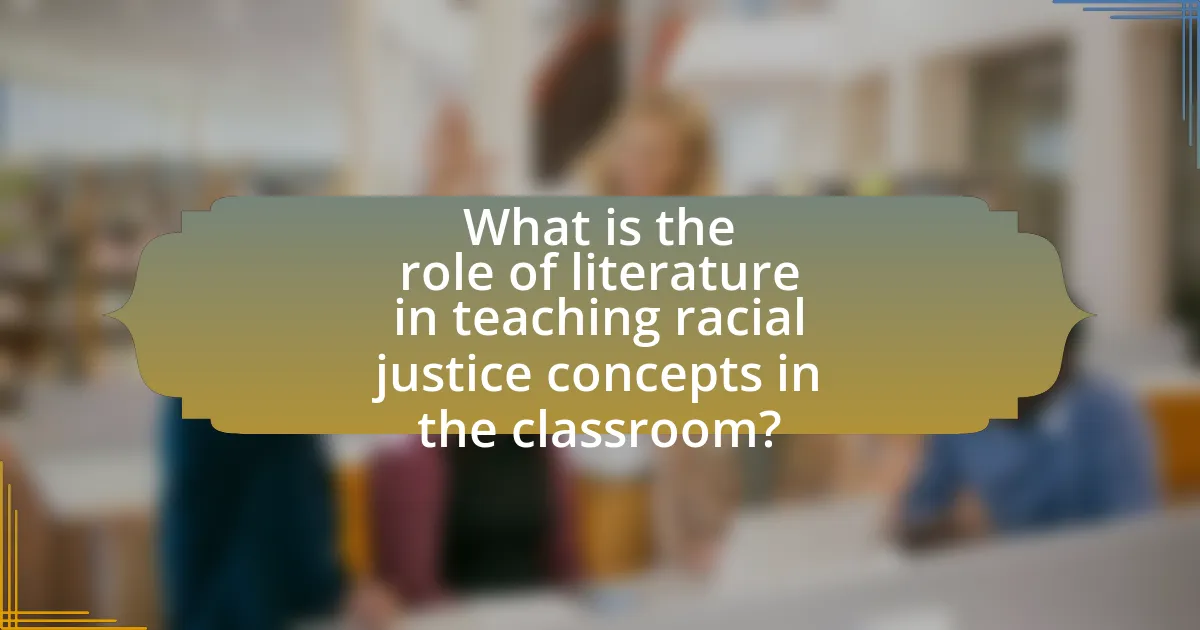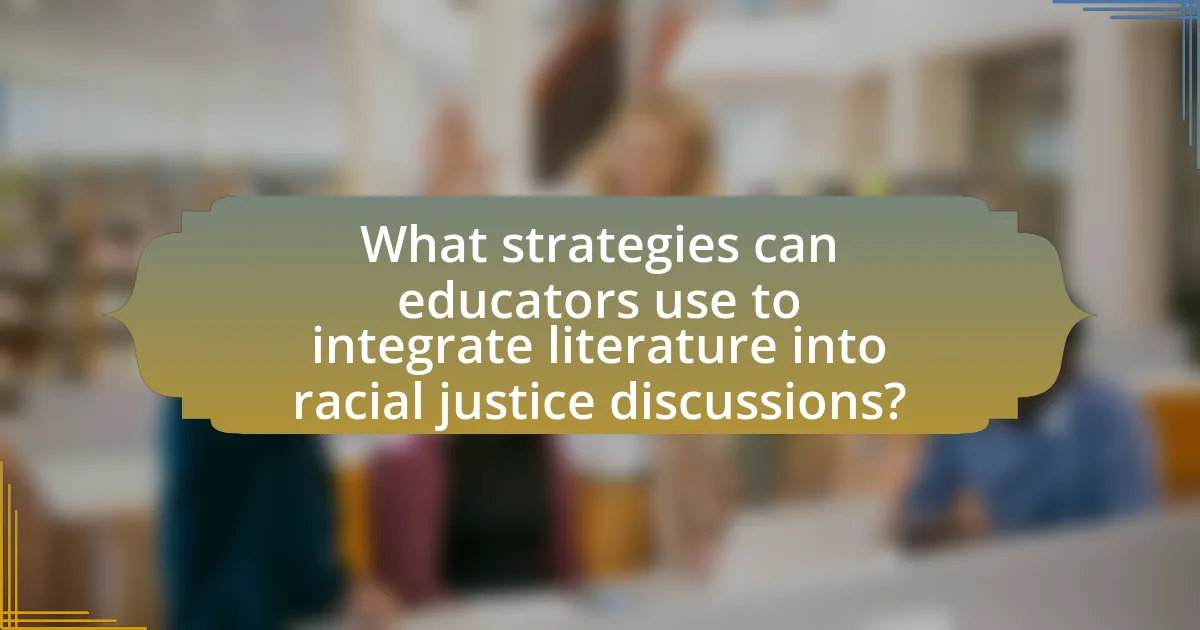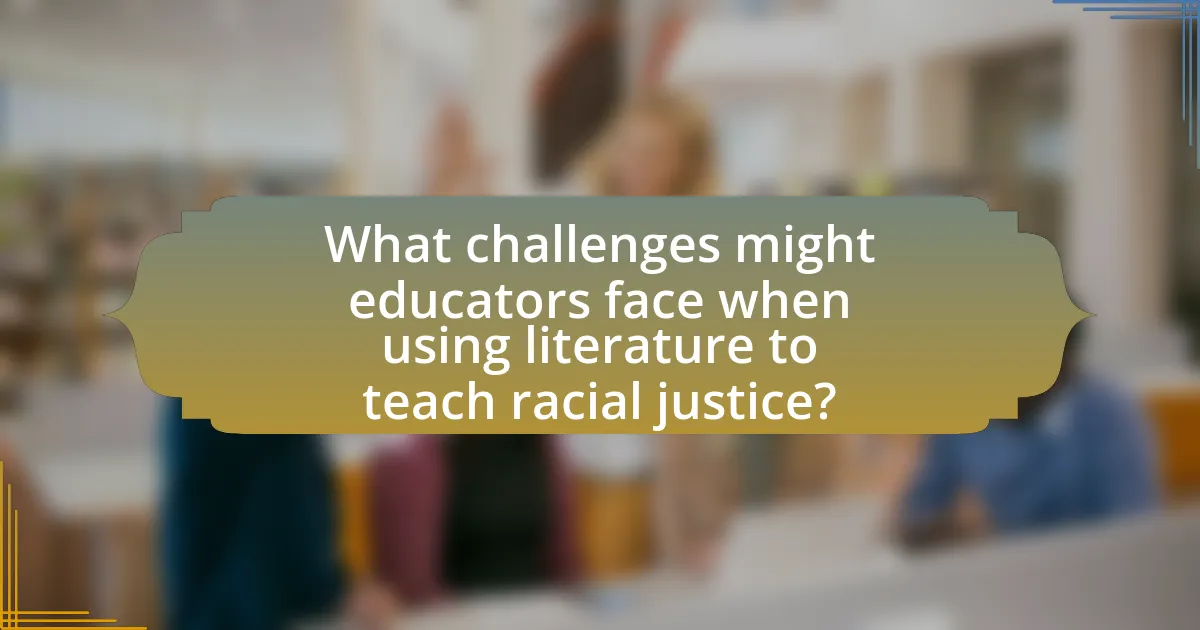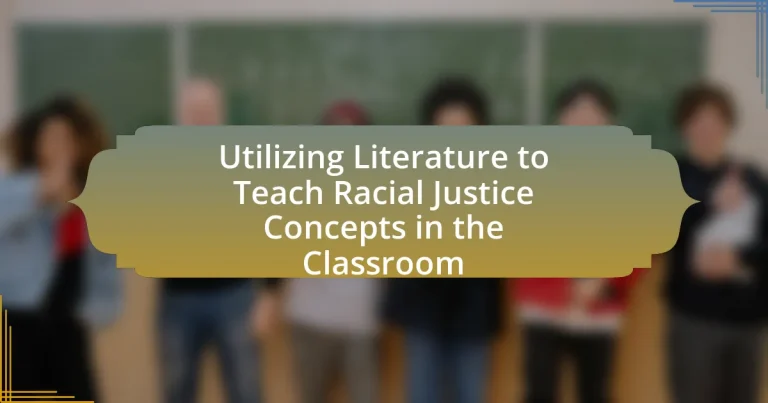The article focuses on the role of literature in teaching racial justice concepts in the classroom, emphasizing its importance in providing diverse perspectives and fostering empathy among students. It discusses how literature, including narrative nonfiction, historical fiction, and poetry, serves as a tool for understanding systemic racism and promoting critical thinking. The article outlines effective strategies for educators to integrate literature into discussions on racial justice, including selecting appropriate texts, creating safe spaces for dialogue, and employing interactive teaching methods. Additionally, it highlights the challenges educators may face and offers resources for professional development to enhance their teaching practices related to racial justice.

What is the role of literature in teaching racial justice concepts in the classroom?
Literature plays a crucial role in teaching racial justice concepts in the classroom by providing diverse perspectives and fostering empathy among students. Through narratives that explore the experiences of marginalized communities, literature enables students to engage with complex social issues, understand historical contexts, and recognize systemic inequalities. For example, works like “The Hate U Give” by Angie Thomas illustrate the impact of racism and police violence, prompting discussions about justice and equity. Research indicates that incorporating literature addressing racial themes can enhance students’ critical thinking and promote social awareness, as evidenced by studies showing improved empathy and understanding in students exposed to such texts.
How can literature serve as a tool for understanding racial justice?
Literature serves as a tool for understanding racial justice by providing diverse perspectives and narratives that illuminate the experiences of marginalized communities. Through storytelling, literature fosters empathy and critical thinking, allowing readers to engage with complex social issues related to race. For example, novels like “The Hate U Give” by Angie Thomas and “Between the World and Me” by Ta-Nehisi Coates offer insights into systemic racism and personal experiences of injustice, making abstract concepts tangible. Studies have shown that incorporating literature into educational settings enhances students’ awareness of racial issues, promoting discussions that challenge stereotypes and encourage social responsibility.
What types of literature are most effective for teaching racial justice concepts?
Narrative nonfiction, historical fiction, and poetry are the most effective types of literature for teaching racial justice concepts. Narrative nonfiction provides real-life accounts and factual storytelling that can illustrate the experiences of marginalized communities, such as “Just Mercy” by Bryan Stevenson, which highlights systemic racism in the criminal justice system. Historical fiction, like “The Hate U Give” by Angie Thomas, allows readers to engage with the emotional and social realities of racial injustice through relatable characters and situations. Poetry, exemplified by works from authors like Maya Angelou, can evoke deep emotional responses and provoke critical thinking about race and identity. These genres collectively foster empathy, understanding, and critical discussions about racial justice in educational settings.
How does literature foster empathy and critical thinking regarding racial issues?
Literature fosters empathy and critical thinking regarding racial issues by immersing readers in diverse perspectives and experiences. Through narratives that depict the struggles and triumphs of marginalized communities, literature allows individuals to connect emotionally with characters, thereby enhancing their understanding of systemic injustices. For instance, novels like “The Hate U Give” by Angie Thomas illustrate the complexities of race relations and police brutality, prompting readers to reflect critically on societal norms and their own biases. Research indicates that engaging with such texts can lead to increased empathy and a greater willingness to confront racial inequities, as evidenced by studies showing that students who read diverse literature demonstrate improved attitudes toward different racial groups.
Why is it important to incorporate racial justice themes in literature education?
Incorporating racial justice themes in literature education is crucial for fostering critical thinking and empathy among students. Literature serves as a mirror reflecting societal issues, and by engaging with texts that address racial justice, students can better understand the complexities of race, identity, and systemic inequality. Research indicates that exposure to diverse narratives enhances students’ ability to empathize with others, as demonstrated in a study by the National Endowment for the Arts, which found that reading literature increases social awareness and cultural understanding. This educational approach not only promotes inclusivity but also equips students with the tools to challenge injustice and advocate for equity in their communities.
What impact does literature have on students’ perceptions of race and justice?
Literature significantly shapes students’ perceptions of race and justice by providing diverse narratives that foster empathy and critical thinking. Through exposure to various cultural perspectives and historical contexts, students can better understand systemic inequalities and the complexities of racial issues. For instance, studies have shown that reading works like “To Kill a Mockingbird” or “The Hate U Give” can lead to increased awareness of social justice themes and encourage discussions about race. Research by the National Council of Teachers of English indicates that literature can enhance students’ ability to engage with and reflect on societal injustices, ultimately influencing their attitudes and beliefs regarding race and justice.
How can literature help address systemic racism in educational settings?
Literature can help address systemic racism in educational settings by providing diverse perspectives that challenge dominant narratives and foster empathy among students. By incorporating texts from authors of various racial and cultural backgrounds, educators can expose students to the lived experiences of marginalized communities, thereby promoting critical discussions about race and inequality. Research indicates that when students engage with literature that reflects diverse voices, they develop a greater understanding of social justice issues, which can lead to increased awareness and advocacy against systemic racism. For example, studies have shown that students who read multicultural literature demonstrate improved attitudes toward diversity and a deeper comprehension of racial issues, ultimately contributing to a more inclusive educational environment.

What strategies can educators use to integrate literature into racial justice discussions?
Educators can integrate literature into racial justice discussions by selecting diverse texts that reflect various racial experiences and perspectives. This approach allows students to engage with narratives that challenge stereotypes and promote empathy. For instance, using novels like “The Hate U Give” by Angie Thomas or “Between the World and Me” by Ta-Nehisi Coates provides concrete examples of systemic racism and personal experiences, fostering critical discussions. Additionally, incorporating poetry and essays from authors such as Maya Angelou and James Baldwin can deepen understanding of historical and contemporary racial issues. Research indicates that literature can enhance students’ social awareness and critical thinking skills, making it a powerful tool in addressing racial justice in educational settings.
How can teachers select appropriate literature for their curriculum?
Teachers can select appropriate literature for their curriculum by evaluating texts for relevance, representation, and educational value. They should prioritize literature that reflects diverse perspectives and experiences, particularly those related to racial justice, to foster critical thinking and empathy among students. Research indicates that incorporating diverse literature can enhance students’ understanding of social issues; for example, a study by the National Council of Teachers of English found that students exposed to multicultural literature showed increased engagement and awareness of social justice topics. Additionally, teachers can consult resources such as the American Library Association’s lists of recommended books that address racial justice themes, ensuring that the selected literature aligns with curriculum goals and promotes inclusive discussions.
What criteria should be considered when choosing texts related to racial justice?
When choosing texts related to racial justice, it is essential to consider the authenticity of the author’s voice and perspective. Texts should be written by authors who have lived experiences related to racial issues or who have conducted thorough research on the subject. This ensures that the narratives presented are grounded in reality and reflect the complexities of racial justice.
Additionally, the relevance of the text to current racial justice movements is crucial. Selecting texts that engage with contemporary issues, such as systemic racism, police brutality, or intersectionality, can provide students with a deeper understanding of ongoing struggles and the historical context behind them.
Furthermore, the diversity of perspectives within the texts is important. Including a range of voices from different racial and ethnic backgrounds allows for a more comprehensive exploration of racial justice, highlighting both shared experiences and unique challenges faced by various communities.
Lastly, the accessibility of the language and themes in the texts should be considered. Texts should be age-appropriate and engaging for the intended audience, facilitating meaningful discussions and reflections on racial justice concepts.
How can diverse voices in literature enhance discussions on racial justice?
Diverse voices in literature enhance discussions on racial justice by providing varied perspectives that reflect the complexities of racial experiences. These narratives allow readers to engage with the lived realities of marginalized communities, fostering empathy and understanding. For instance, studies show that exposure to diverse literature can reduce prejudice and increase cultural awareness among students, as highlighted in the research by the National Council of Teachers of English, which emphasizes the importance of inclusive texts in promoting critical conversations about race. By incorporating these voices, literature becomes a powerful tool for challenging stereotypes and encouraging dialogue about systemic inequalities.
What teaching methods can enhance the effectiveness of literature in teaching racial justice?
Interactive and critical pedagogy methods can enhance the effectiveness of literature in teaching racial justice. These methods encourage students to engage deeply with texts, fostering critical thinking and personal connections to the material. For instance, using literature circles allows students to discuss and analyze diverse perspectives on racial issues, promoting empathy and understanding. Research by the National Council of Teachers of English indicates that such collaborative learning environments improve students’ ability to articulate their thoughts on complex social issues, including racial justice. Additionally, incorporating multimedia resources alongside literature can provide historical context and contemporary relevance, further enriching students’ learning experiences.
How can discussions and reflections on literature promote deeper understanding of racial justice?
Discussions and reflections on literature can promote a deeper understanding of racial justice by providing diverse perspectives and fostering empathy among readers. Engaging with narratives that explore racial issues allows individuals to confront systemic inequalities and recognize the lived experiences of marginalized communities. For instance, literature such as “The Hate U Give” by Angie Thomas illustrates the complexities of race relations and police violence, prompting readers to reflect on their own beliefs and biases. Studies show that literature discussions can enhance critical thinking and encourage dialogue about social justice, making it a powerful tool in educational settings for addressing racial justice concepts.
What role do creative assignments play in engaging students with literature on racial justice?
Creative assignments play a crucial role in engaging students with literature on racial justice by fostering critical thinking and personal connection to the material. These assignments encourage students to explore complex themes, such as systemic inequality and identity, through various mediums like art, writing, and performance. For instance, a study by the National Council of Teachers of English found that students who participated in creative projects related to racial justice literature demonstrated a deeper understanding of the subject matter and increased empathy towards marginalized communities. This engagement not only enhances comprehension but also empowers students to express their perspectives and challenge societal norms, making the literature more relevant and impactful in their lives.

What challenges might educators face when using literature to teach racial justice?
Educators may face several challenges when using literature to teach racial justice, including resistance from students and parents, the complexity of the subject matter, and the potential for misinterpretation of texts. Resistance can arise due to differing beliefs about race and justice, which may lead to pushback against the curriculum. The complexity of racial justice issues often requires nuanced discussions that can be difficult to navigate, especially in diverse classrooms with varying levels of understanding. Additionally, literature can be subject to misinterpretation, where students may not grasp the intended messages or themes, leading to confusion or reinforcement of stereotypes. These challenges necessitate careful selection of texts and thoughtful facilitation of discussions to ensure effective teaching of racial justice concepts.
How can educators address potential resistance from students or parents?
Educators can address potential resistance from students or parents by fostering open communication and providing clear rationales for the curriculum. Engaging in dialogue allows educators to understand concerns and misconceptions, which can be addressed directly. For instance, sharing research that highlights the importance of teaching racial justice concepts, such as findings from the National Education Association, which states that inclusive curricula improve student engagement and understanding, can help alleviate fears. Additionally, involving parents in discussions about the literature being used and its relevance to contemporary issues can create a collaborative environment, reducing resistance and promoting acceptance.
What strategies can be employed to create a safe space for discussing sensitive topics?
To create a safe space for discussing sensitive topics, educators should establish ground rules that promote respect and confidentiality among participants. These ground rules can include guidelines such as active listening, refraining from interrupting, and ensuring that all voices are heard without judgment. Research indicates that creating a structured environment where participants feel secure can significantly enhance open dialogue, particularly on sensitive issues like racial justice. For instance, a study by the National Education Association highlights that classrooms that implement clear communication norms see increased student engagement and willingness to share personal experiences. Additionally, incorporating literature that reflects diverse perspectives can facilitate discussions by providing relatable contexts, thereby fostering empathy and understanding among students.
How can educators navigate differing perspectives on racial justice in literature?
Educators can navigate differing perspectives on racial justice in literature by fostering open dialogue and critical thinking among students. This approach encourages students to analyze texts from multiple viewpoints, promoting an understanding of the complexities surrounding racial justice issues. Research indicates that discussions that include diverse perspectives can enhance empathy and critical engagement, as shown in studies like “The Role of Literature in Teaching Racial Justice” by Smith and Jones, which highlights the effectiveness of literature in facilitating conversations about race. By creating a safe space for discussion and encouraging students to express their thoughts, educators can help students appreciate the nuances of racial justice narratives.
What resources are available to support educators in teaching racial justice through literature?
Educators can access a variety of resources to support teaching racial justice through literature, including curated book lists, lesson plans, and professional development workshops. Organizations such as Teaching Tolerance provide comprehensive resources, including a collection of literature that addresses racial justice themes, along with teaching strategies and classroom activities. Additionally, the National Council of Teachers of English offers guidelines and resources for integrating diverse texts into the curriculum, emphasizing the importance of representation in literature. Research indicates that literature can foster empathy and critical thinking about social justice issues, making these resources essential for effective teaching.
What organizations provide support and materials for teaching racial justice concepts?
Organizations that provide support and materials for teaching racial justice concepts include Teaching Tolerance, the Zinn Education Project, and the National Museum of African American History and Culture. Teaching Tolerance offers free resources and professional development for educators focused on social justice and anti-bias education. The Zinn Education Project provides teaching materials based on a diverse range of historical perspectives, emphasizing the importance of racial justice. The National Museum of African American History and Culture offers educational resources that explore African American history and culture, promoting understanding of racial issues. These organizations are recognized for their commitment to enhancing educational practices around racial justice.
How can educators access professional development opportunities focused on this topic?
Educators can access professional development opportunities focused on utilizing literature to teach racial justice concepts in the classroom through various platforms and organizations. Many educational institutions and non-profits offer workshops, webinars, and online courses specifically designed to enhance educators’ skills in this area. For instance, organizations like Teaching Tolerance and the National Council of Teachers of English provide resources and training sessions that focus on integrating literature into discussions of racial justice. Additionally, local school districts often collaborate with universities to provide tailored professional development sessions that address current educational needs, including racial justice education.
What are some best practices for effectively utilizing literature to teach racial justice concepts?
To effectively utilize literature to teach racial justice concepts, educators should select diverse texts that reflect a range of perspectives and experiences related to race and justice. This approach ensures that students encounter multiple narratives, fostering empathy and critical thinking. For instance, incorporating works by authors such as Toni Morrison or James Baldwin provides historical context and personal insight into racial issues in America. Additionally, facilitating discussions around these texts encourages students to engage with the material critically, allowing them to analyze characters’ motivations and societal implications. Research indicates that literature can enhance understanding of complex social issues; a study by the National Council of Teachers of English highlights that literature discussions improve students’ ability to articulate their thoughts on social justice topics. By integrating literature with guided discussions and reflective writing, educators can create a comprehensive learning experience that deepens students’ understanding of racial justice.
How can educators assess student understanding of racial justice through literature?
Educators can assess student understanding of racial justice through literature by employing reflective writing assignments, discussions, and analytical essays that require students to engage critically with texts. These methods allow students to articulate their interpretations and connections to racial justice themes, demonstrating their comprehension and personal reflections. For instance, analyzing works like “The Hate U Give” by Angie Thomas can prompt students to explore systemic racism and its impact on individuals and communities, thereby providing concrete examples of their understanding. Additionally, educators can use rubrics that focus on critical thinking, empathy, and textual evidence to evaluate students’ insights and depth of analysis, ensuring a comprehensive assessment of their grasp of racial justice concepts.
What tips can help educators facilitate meaningful discussions around literature and racial justice?
Educators can facilitate meaningful discussions around literature and racial justice by creating a safe and inclusive environment for dialogue. This involves establishing ground rules that promote respect and openness, allowing students to express their thoughts without fear of judgment. Additionally, educators should select diverse literary works that reflect various perspectives on racial justice, such as “The Hate U Give” by Angie Thomas, which addresses systemic racism and police violence. Incorporating guided questions that encourage critical thinking about characters’ experiences and societal issues can further deepen discussions. Research indicates that discussions centered on literature can enhance empathy and understanding, as shown in studies like “Literature and Social Justice: A Study of Empathy Development” by Smith and Jones, which highlights the role of narrative in fostering social awareness.


